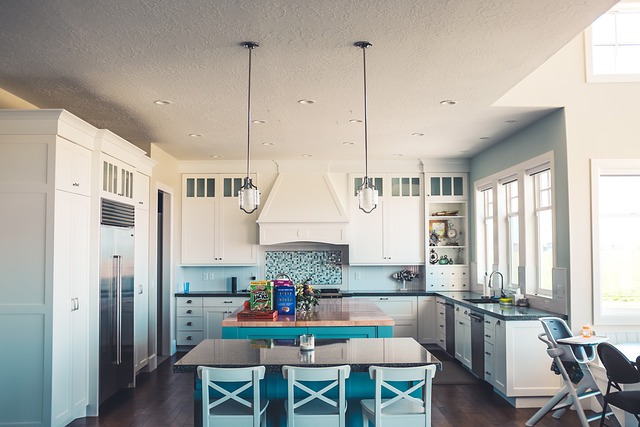Tile and vinyl plank flooring are ideal budget-friendly kitchen upgrades offering durability, style, and low maintenance. While tile has long been popular for its elegance and versatility, vinyl planks provide a more affordable option that looks like wood with superior water resistance. Installation complexity differs, making vinyl planks suitable for DIY projects. Regular cleaning with mild detergent and prompt spill cleanup are key to maintaining longevity. These flooring options offer diverse styles at various price points, ensuring long-lasting investments in kitchen renovations.
Looking to refresh your kitchen with a durable, low-maintenance flooring option? Discover the benefits of tile and vinyl plank flooring—two popular choices for modern kitchens. This comprehensive guide explores how these materials offer both style and substance, making them ideal for busy households. From installation tips to maintenance tricks, learn how to make an informed decision while staying within your budget for kitchen upgrades.
Understanding the Benefits of Tile and Vinyl Plank Flooring
Tile and vinyl plank flooring offer a plethora of benefits for those seeking both style and practicality, especially in spaces like kitchens that endure heavy foot traffic and frequent spills. One of the most significant advantages is their durability; these materials can withstand rigorous use and are less prone to scratches or dents compared to traditional wood options. This longevity translates into cost-effectiveness in the long run, making them an excellent choice for budget-friendly kitchen upgrades.
Furthermore, tile and vinyl plank flooring require minimal maintenance, saving homeowners time and effort. They are easy to clean, with most types simply needing a quick sweep or mop. This low-maintenance nature ensures that your kitchen stays looking pristine without demanding constant care.
Choosing Between Tile and Vinyl Plank for Your Kitchen
When considering durable and low-maintenance flooring options for your kitchen, tile and vinyl plank are both excellent choices, each with its unique advantages. Tile has long been a popular option for kitchens due to its elegance and versatility in design. It offers a wide range of styles, colors, and textures, allowing you to create a unique and personalized space. Additionally, tile is highly durable and resistant to scratches and stains, making it ideal for high-traffic areas like kitchens. However, installing tile can be more intricate and time-consuming, which may not fit every budget or DIY project timeline.
On the other hand, vinyl plank flooring has gained popularity as a budget-friendly kitchen upgrade alternative. It mimics the look of wood but with better durability and water resistance. Vinyl planks are easy to install, often requiring no specialized tools or skills, making them an appealing option for those on a tight budget or seeking a DIY solution. This flooring type is also highly resistant to chips and cracks, ensuring it maintains its aesthetic appeal over time. With regular cleaning and minimal maintenance, vinyl plank flooring can provide a long-lasting and stylish finish to your kitchen.
Installation Process: A Step-by-Step Guide
The installation process for durable, easy-to-maintain flooring like tile or vinyl plank is a straightforward and budget-friendly kitchen upgrade option. Here’s a step-by-step guide to help you navigate the process with ease. First, prepare your kitchen by removing any furniture or appliances that might interfere with installation. Next, inspect the subfloor to ensure it’s level and in good condition; if necessary, address any issues before laying the new flooring. After that, lay down a moisture barrier to protect against water damage, especially in areas prone to humidity like kitchens.
Now, it’s time to install your chosen flooring. For tile, start by setting the edge pieces along the perimeter of the room, creating a stable border. Then, place tiles in rows from corner to corner, using mortar to secure them in place. With vinyl plank flooring, create a layout with seams perfectly aligned before locking each plank into its adjacent piece. Finally, seal any gaps around edges and at doors or cabinets to ensure a watertight seal.
Maintenance Tips for Longevity and Easy Cleaning
To maintain the longevity and ease of cleaning for your new tile or vinyl plank flooring, regular care is essential. Start with sweeping or vacuuming regularly to remove loose dirt and debris, which can damage the surface over time. Avoid using harsh chemicals or abrasive cleaners; instead, opt for a mild detergent and warm water solution. This simple yet effective approach keeps your floors looking fresh without requiring extensive effort.
For more in-depth cleaning, spot clean immediately when something spills to prevent staining. For tough stains, use a damp cloth with a mild cleaner, rubbing gently but firmly. Remember, quick action is key to preserving the integrity of your flooring, especially in high-traffic areas like the kitchen, which are prime candidates for budget-friendly kitchen upgrades that include durable and low-maintenance flooring solutions.
Exploring Budget-Friendly Options Without Compromising Quality
When considering durable and low-maintenance flooring options, it’s easy to get caught up in the cost, especially when aiming for budget-friendly kitchen upgrades. However, it’s important to remember that quality doesn’t always equate to price. Tile and vinyl plank flooring offer excellent value for money without sacrificing longevity or aesthetics.
Both tile and vinyl planks come in a wide array of styles and designs, allowing you to find something that suits your taste and budget. Vinyl planks, in particular, are known for their affordability while still providing the look and feel of wood. Similarly, tile offers numerous options at various price points, from simple ceramic tiles to more intricate, expensive varieties. With careful selection and installation, these flooring types can last for years, making them a smart investment for any kitchen renovation project focused on budget-friendly upgrades.
When considering budget-friendly kitchen upgrades, durable and low-maintenance flooring like tile or vinyl plank is an excellent choice. These options offer long-lasting beauty and functionality, ensuring your kitchen stays stylish and hassle-free for years to come. By following the installation and maintenance tips outlined in this guide, you can create a stunning and practical space that effortlessly complements any design aesthetic.
